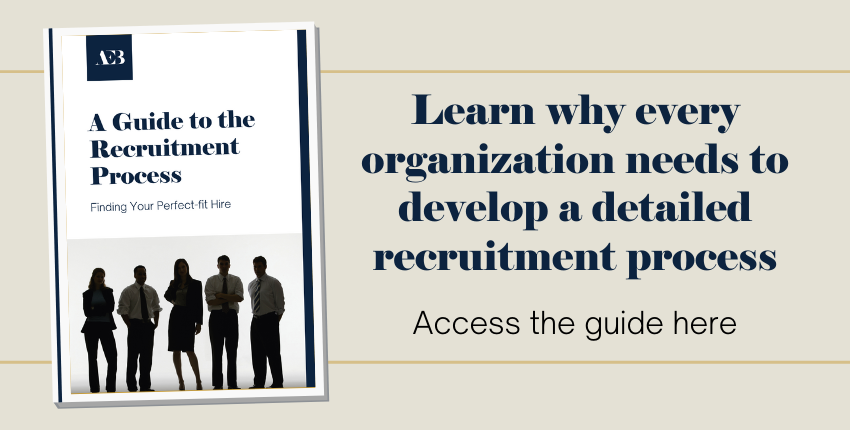What is the hiring process at your company? Maybe we should back up and first ask if your organization has a hiring process. And if so, is it followed?
If you have ever worked on a project (either alone or in a team) that did not have a defined process in place, most likely something at some point did not go smoothly. And it’s exactly because of mishaps like this, that process and project management roles and certifications even exist.
While the hiring process may not be as complex as most product development projects in a manufacturing or information technology capacity, the purpose and reasoning for their existence are the same. A process provides a way and method of progressing from start to finish to achieve the best possible outcome.
Placed in the context of talent acquisition, a hiring process is a systematic way of moving as effectively as possible from the point of having an open position to the point of having your perfect-fit hire begin their first day of employment.
At AEBetancourt, we believe so strongly in the advantages and results of a defined hiring process, that we wanted to share our framework to help you in structuring your own process.
The Systematic Steps in a Hiring Process
Pre-process steps
A successful hiring process begins even before the actual work of sourcing, recruiting, and interviewing candidates. So step one is to clarify your hiring process. For the Human Resources professional, this means understanding and clarifying what your hiring manager is thinking of and expecting from you.
Essentially your aim is to ensure the hiring manager has a process and knows what will happen when a candidate is presented to them. If an internal hiring process is not in place, your first course of action is to help them define that.
In this phase you are seeking to understand several things:
-
Who the hiring manager and final decision-maker(s) are?
-
What information (such as input from other team members, personality testing, etc.) is needed to make a confident hiring decision?
-
How many interviews are needed, what format will they be (phone, video, or both options), who will conduct them, and the planned outcome of each?
-
Between Human Resources, the hiring manager, and key team members, who will be responsible for each part of the hiring process?
The goal is to establish a clearly defined structure and then ensure it will be closely adhered to.
Talent Acquisition steps
Even once the actual recruitment part of the hiring process begins, there are still a couple of steps you should insist on to ensure accuracy and complete understanding. Of course every candidate search is different, with its own nuances and characteristics. This means the following steps should be used as a guide. (Note: if you do use an outside recruitment firm, this should serve as a minimum expectation for anyone you may work with.)
Hiring manager survey
Any position our team recruits for begins with a survey completed by the hiring manager. If you don’t have some formal or informal written questionnaire, do the work and create this right away.
The purpose of this survey is to organize and outline the information essential for finding your perfect-fit hire. The questions clarify many of the expected pieces of information like the title of the role, compensation plan, benefits package, and reporting structure. However, you should also seek to understand the Employee Value Proposition (EVP) for the department you are assisting and your organization as a whole. Plus, what they seek to have this individual accomplish at the end of their first year.
Build a search file
With the information gained from the survey, build a search file that includes these four important documents that your team can constantly refer back to. These include:
-
A detailed profile of your company and the department their new hire will be joining that describes how our team will source, identify, and connect with target candidates.
-
Your candidate scorecard. List out the specific requirements your hiring manager is looking for with the tools, talents, and personality traits each candidate possesses.
-
A reporting system that is openly shared with your hiring manager noting all search activity and the results.
-
An initial benchmark list of sample resumes or LinkedIn profiles. The will serve as your guideposts for candidates that meet or miss the ideal qualifications throughout your hiring process.
Search onboarding meeting
The final step before beginning to source candidates is to have an onboarding meeting with your hiring manager. This meeting is critical to the hiring process because it is where your understanding of the hiring manager’s needs are confirmed or clarified. Additionally, expectations, timing, and your overall process are reviewed once more. Skipping this step creates a substantial risk for your involvement in this process. Here’s why.
Without reviewing your benchmark list of sample candidates, you could easily reach the end of your sourcing and vetting process, introduce a number of qualified candidates, and have your hiring manager pass on all of them simply because some criteria was not previously discussed.
Search process
Based on the profile and resulting search strategy you created, candidates are sourced through a wide variety of methods that could include online searches, referral recommendations and networking, or even old-school cold calling.
It is important to note that this should be the first point in the hiring process where direct involvement from the hiring manager (or final decision maker) is not 100% essential to hiring your next perfect-fit employee.
Phone screen interviews
While these interviews provide a great deal of first impression feedback, they do provide much more value to understanding candidate fit. Since the majority of these positions are not posted online, most candidates need and want to know why the role is available and why they might want to make a career move. (This is another reason the initial work and survey responses are critical to collect and clarify.) However, these initial phone screenings also provide the first chance to match candidates against your candidate scorecard to determine if they potentially meet your hiring manager's requirements.
These initial screenings only need to be 15-30 minute conversations, but for passive candidates (those not actively looking for a career change) they are very important. Your job now is to “sell to screen”. This means selling them (or actively recruiting) to help them advance to the next phase in your hiring process.
Face-to-face interviews
At this stage, you will have your first real opportunity to vet candidates and more adequately score them for your hiring manager’s perfect-fit match ideals. Depending on your business climate and specific needs, these face-to-face interviews could be in the format of video calls or actual in-person meetings. We recommend a structured interview process called the “A method”, also referred to as a top grading interview method.
The approach is to have a candidate walk a recruiter or HR professional through their resume from past to present explaining their responsibilities, accomplishments, and reasons for leaving each role they have had.
Presentations
While not nearly as formal as it sounds, this is simply the handoff process of sharing candidates that have initially scored well after the phone screening and face-to-face interview(s) with the hiring manager. At this point, your hiring manager will complete their pre-planned portion of the hiring process.
Offer extended
Taking the positive side, once a candidate has completed the entire hiring process with both your recruiting team and the hiring manager, and is a match against the preset list of desired and needed qualifications, an offer is extended to the candidate.
Why a Structured Hiring Process Matters
Depending on your personality style and business experiences, the above process might seem either extremely rigid or proficiently organized. But let me assure you, skipping over steps or changing the order of this hiring process will only yield less-than-desired results at best.
Here’s why we use this process every time.
Avoids errors and achieves client goals
Take a look again at the steps we listed above. Each one of the hiring process steps builds on the previous one. On the low-risk side, skipping a step allows search criteria to change and allows scope creep to slowly erode your initial goals. The higher risk consequences include needless additional costs being accrued, a drawn-out search process, and ultimately either the wrong candidate or even no candidate is hired.
When we guide our clients through this structured hiring process, the results are companies hiring their ideal candidates in less time and for less cost than other recruiting and hiring methods. We’re confident you can do the same for your hiring managers.
Puts our clients first
One of our foundational company values is to “act as partners” for our clients. This means we are transparent, honest, and open about our work results and align our actions with our client’s interests. We also seek solutions that will build success toward our partners’ immediate and long-term talent strategy goals.
We have zero incentives to push just any candidate to make a placement. Our only goal is to find the right candidate and let our clients make the hire. Our job is to make the process easier and faster.
Recruiting isn’t rocket science, but it is a matter of loyalty, respect, and doing what will help companies grow, develop, and succeed. Meaning we work to become an extension of your team, not another vendor you transact with at arm’s length.
Curious if your talent acquisition methods are on the right path? Access our guide below to see where you may have opportunities to enhance your process.









